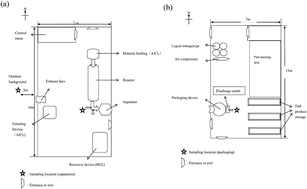Workplace exposure to airborne alumina nanoparticles associated with separation and packaging processes in a pilot factory
Abstract
Workplace exposure to airborne Al2O3 nanoparticles in a pilot factory was characterised by particle concentrations, size distribution, morphology and chemical composition, compared with background particles. Real-time variations in number concentration (NC20–1000 nm), respirable mass concentration (MC100–1000 nm), active surface area concentration (SAC10–1000 nm) and particle size were measured at production locations involved in separation and packaging activities. Measurements during stable production periods showed significant increases in the various concentrations of agglomerated Al2O3 nanoparticles (about 305 nm) at separation locations, compared to those of background particles (p < 0.01). The size distribution model for separation processes might switch to primary nanoparticles (21–26 nm) during periods of unstable production. Packaging activities also caused significant increases in different concentrations of Al2O3 nanoparticles (about 90 nm) compared to background particles (p < 0.01). These particles exhibited a bimodal size distribution and floccus or cloudy-like agglomerates of primary nanoparticles. NC20–1000 nm and active SAC10–1000 nm variations showed the same trend, and were temporally consistent with particle emission scenarios or worker activities, but differed from that for respirable MC100–1000 nm. There was strong correlation between active SAC10–1000 nm and NC20–1000 nm (r = 0.823), moderate correlation between active SAC10–1000 nm and respirable MC100–1000 nm (r = 0.666) and relatively weak correlation between NC20–1000 nm and respirable MC100–1000 nm (r = 0.361). These findings from the pilot factory suggest significant exposure to Al2O3 nanoparticles or their agglomerates, associated with separation and packaging processes. The number and active surface area concentrations may be distinct from mass concentration and might be more appropriate for characterizing exposure to airborne nanoparticles.


 Please wait while we load your content...
Please wait while we load your content...